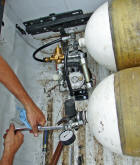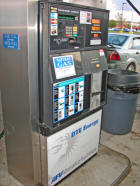|
| |
CNG, is it the Answer for the Fuel
Crisis?
Or All American Super Flex Fuel
H. Kent Sundling
|
Update: we dyno our CNG mule.
 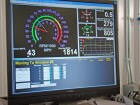 Six
inches of snow on the ground, cold January day in
Colorado. We took our test mule to Engle Automotive in
Loveland for the dynameter test. In Front Range
counties, Colorado requires diesels to be tested for
emissions. Our test truck with the CNG conversion passed
with and without gas. Similar results, CNG helped the
middle RPM range lower emissions. Six
inches of snow on the ground, cold January day in
Colorado. We took our test mule to Engle Automotive in
Loveland for the dynameter test. In Front Range
counties, Colorado requires diesels to be tested for
emissions. Our test truck with the CNG conversion passed
with and without gas. Similar results, CNG helped the
middle RPM range lower emissions.
Power proved what
my butt dyno was saying. Torque improved 285 ft. lbs of
torque (correction 245 torque) with CNG and horsepower up 85. Just returned from
California, bought CNG in Utah for $.88
Gasoline Gallon Equivalent. When I know it's the next
CNG fill up is way down the road, I save the CNG for
mountains and long grades.
Video....
|
 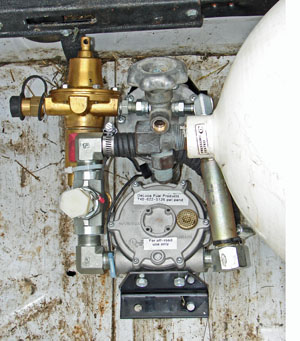 Forget
veggie oil, bio-diesel, power programmers and hydrogen water
separators. And hear the gospel of CNG/diesel. The beauty of
this system is if I can't find a Compressed Natural Gas fill up
station, I just run on diesel. We've now had time to run several
tanks through our test truck in a loop using both CNG and diesel
together at 2 to 1 (2 CNG gallons to 1 diesel gallons) without a
trailer and about 1 to 1 with a trailer. We reduced our fuel
cost per mile 23% to 27% with Colorado prices. Almost double
that with Utah prices, (details below.) Which
is like buying diesel at $3 instead of $4 or increasing MPG by
25%.
CNG prices range from $.50 to $1.20 cheaper than diesel. And did I mention more power? It's not about waiting for a
hybrid truck or hydrogen fuel cell to save us, but something we
have in abundance in the USA that we can use now. You see the T.
Boone Pickens ads on TV every day. There's something to his plan
with natural gas. Propane and CNG have been used to boost diesel engine
power, but I'm talking about replacing most of the diesel with
CNG. Forget
veggie oil, bio-diesel, power programmers and hydrogen water
separators. And hear the gospel of CNG/diesel. The beauty of
this system is if I can't find a Compressed Natural Gas fill up
station, I just run on diesel. We've now had time to run several
tanks through our test truck in a loop using both CNG and diesel
together at 2 to 1 (2 CNG gallons to 1 diesel gallons) without a
trailer and about 1 to 1 with a trailer. We reduced our fuel
cost per mile 23% to 27% with Colorado prices. Almost double
that with Utah prices, (details below.) Which
is like buying diesel at $3 instead of $4 or increasing MPG by
25%.
CNG prices range from $.50 to $1.20 cheaper than diesel. And did I mention more power? It's not about waiting for a
hybrid truck or hydrogen fuel cell to save us, but something we
have in abundance in the USA that we can use now. You see the T.
Boone Pickens ads on TV every day. There's something to his plan
with natural gas. Propane and CNG have been used to boost diesel engine
power, but I'm talking about replacing most of the diesel with
CNG.
Part of the story, is how hard
it is to get CNG fuel. Hard to find in some states and complicated to buy
in other states.
Many fueling stations use a special card only, that you have to
apply for. Mark Deluca installed my unit in Ohio, he had to fill
me up, as a special card was required, the same for a station in
Indiana.
I had to go to Ann Arbor near Detroit to get my next fill. And
since CNG stations are farther apart than my two 10 gallon tanks
will run, I can't get a tank to tank read on what my cost per
mile is. Which is the only accurate way to judge what I'm saving
by using CNG. A week ago I faxed in my application to Clean
Energy, which controls all the CNG filling stations in Colorado.
I downloaded the app from
www.CleanEnergy.com and faxed in my 4 page application plus
copy of credit card and drivers license. They require a $100
deposit and bill your credit card a day after you use their
special cards to buy CNG. Clean Energy HQ is in California where
they operate dozens of stations that use credit cards like a gas
station. This should spread to other stations around the country
as CNG becomes more popular. Clean Energy bought Phill Home
Fueling Stations (www.myphill.com)
which install on your homes gas line for CNG filling with low
pressure (one gallon per hour). Clean Energy is also in a joint venture with GM for
opening Hydrogen cell fueling stations. T. Boone Pickens owns
part of Clean Energy.
In the Clean Energy station locator brochure
that came with my fuel cards, is a listing for fill station on Ft. Carson Army base near Colo. Springs Colo. Yes I filled there, after the gate private contractors searched my truck and warned me I could be arrested on the Army base for wondering around. Not sure why, the gate guards didn't know there was a public CNG fill station there or what CNG was. So after a phone call, they did tell me where it might be. Filled my tanks and got out of there. Could have used a warning in the Clean Energy locator brochure about military bases. So far I've bought fuel in Colorado, Ohio, Michigan, Kansas and Oklahoma. But just one military base. Most stations are located near government centers,
airports or natural gas service centers.
As a kid on the farm, we had a propane Minneapolis
Moline farm tractor, filling propane was a pain. But CNG is a
snap with just a coupler, similar to a air compressor coupling
with a locking lever. Gasoline Gallon Equivalent is how CNG is
sold at the pump, so you don't have to bring your calculator to
convert BTU's into cubic feet and then into gallons. You're
buying natural gas as equal to a gallon of gasoline.
So far using CNG in my 2006 Ford F250 diesel test truck added
180 miles to my overall range. 280 miles on CNG/diesel with a
trailer using two 10 gallon tanks.
Paid $2.19 for CNG in Ohio in September, $1.94 in Michigan, $1.26 in Oklahoma and finally dropped in Colorado to $2.09. Twenty CNG stations in my
state, Colorado, 62 in Utah, 51 in Oklahoma, 92 in New York, 40
in Arizona and 183 stations in California. 778 stations in the
country. Utah ($.80 this week) and Oklahoma ($1.14) have the
cheapest fuel. For current prices and locations,
http://www.cngprices.com/
 With
diesel and gas prices doubling in one year, no one was prepared
for this. We knew higher prices were coming and oil is running
out, but not all at once. We all feel the pain, from fuel
prices. But the good side and there always is a good side if you
look hard, the dramatic fuel price increase has put the whole
country on alert speeding up development and brain storming for
a solution. With
diesel and gas prices doubling in one year, no one was prepared
for this. We knew higher prices were coming and oil is running
out, but not all at once. We all feel the pain, from fuel
prices. But the good side and there always is a good side if you
look hard, the dramatic fuel price increase has put the whole
country on alert speeding up development and brain storming for
a solution.
For the businesses that survived the fuel crisis, bank crisis and bail out crisis, it's time to sort through the new ideas for the real improvements in mpg for commercial trucks and pickup trucks. I've tried engine programmers, bigger exhaust, bigger air intake, roof wings, lower air dams, tonneau covers etc. and never got a large improvement of more than 10%.
Reading Diesel Power Magazine with a diesel truck mod shootout,
one of the trucks had CNG added to a Duramax getting 38 mpg.
Sounded interesting but didn't sink in until my nephew Greg
called, wondering if I had more info on CNG. Researched the
source and found Marc Deluca in Ohio up to his elbow's in
installing CNG on diesels.
http://www.delucafuelproducts.com/ Called some engineers at
Ford to see what would happen if I added CNG to our test truck,
a 2006 F250 with the 6.0L Power Stroke diesel with new head
gaskets, new EG cooler and 65,000 miles. The main concern was
boost and internal cylinder pressures. The boost was actually
reduced with CNG. We may try a boost regulator before we go to
larger loads than the 10,000 lb trailer we're using now. My
concern was lubricity since I would be using less diesel, I was
told by an engineer that lubricity wasn't a problem as only
diesel was going through the injectors and pump where lubrication was a
concern. CNG was entering the engine through the air intake,
mixing CNG with air in the turbo.
 Mark Deluca explained that CNG makes the engine more efficient,
diesel explodes in the center bowl of the piston and leaves some
oxygen and diesel unburned in the outside ring of the piston.
CNG helps use the fuel and oxygen in the outside ring, giving
you more power. Diesel engines compress hot air and CNG for a
more complete burn of fuel and air in the compression stroke.
Since adding the CNG venturi tube in the air snorkel after the air
filter, the low pressure fumigation system, CNG fuel is sucked into the
turbo and mixes air with CNG as it travels through the turbo and
intercooler on it's way to the engine. No CNG is used at idle
and it takes about 1500 rpm to open the spring valve on the
regulator for the gas to flow. Drawing CNG into intake manifold
has advantages over bio-diesel or waste oil which goes thru
pumps and injectors causing some problems on seals and o-rings or
gelling from cooking oil waste/fuel. Mark Deluca explained that CNG makes the engine more efficient,
diesel explodes in the center bowl of the piston and leaves some
oxygen and diesel unburned in the outside ring of the piston.
CNG helps use the fuel and oxygen in the outside ring, giving
you more power. Diesel engines compress hot air and CNG for a
more complete burn of fuel and air in the compression stroke.
Since adding the CNG venturi tube in the air snorkel after the air
filter, the low pressure fumigation system, CNG fuel is sucked into the
turbo and mixes air with CNG as it travels through the turbo and
intercooler on it's way to the engine. No CNG is used at idle
and it takes about 1500 rpm to open the spring valve on the
regulator for the gas to flow. Drawing CNG into intake manifold
has advantages over bio-diesel or waste oil which goes thru
pumps and injectors causing some problems on seals and o-rings or
gelling from cooking oil waste/fuel.
You can also
convert your gas engine to CNG, a diesel conversion though doesn't have problems with predetonation
or need knock sensors like a gas conversion. Diesel engines is
built for heavy duty use, exploding diesel with heat and
combustion not spark. This all makes diesel engines the ideal
CNG conversion candidate.
Talked to farmers in Ohio who built a portable unit with
regulators and argon gas tanks for CNG that lifts out of their Dodge
2500 with Cummins diesel and onto a combine for corn harvest. They
have natural gas wells and get some free CNG. Even with an
expensive step-up pump, they said they saved a couple hundred
dollars a day using CNG in farm equipment.
Major companies are working on CNG projects, John Deere has CNG
gas engines in trucks and buses, Cummins has a CNG engine and in
2001 Cummins had a 15 L Cummins/Westport LNG/diesel (Liquefied
Natural Gas) that they
tested which burned mostly LNG with a dual injector with diesel.
Mahindra Tractors is launching new models, using CNG and LPG.
They estimate that the new models will be at least 30 per cent
more fuel-efficient than diesel-run tractors. UPS bought 167 new CNG vehicles in April this year.
UPS seems to be on the cutting edge with new technology using
diesel hybrids and hydraulic propulsion.
 CNG,
which is 80 to 95 percent methane gas, "Natural" gas is the
key word here, same methane you smell driving by a feedlot
or dairy. Waste Management harvests methane natural gas from
it's landfills to run their garbage trucks. Methane gas is
renewable.
Natural gas has a simple chemical
make-up: one molecule of carbon and four molecules of
hydrogen (CH4). CNG,
which is 80 to 95 percent methane gas, "Natural" gas is the
key word here, same methane you smell driving by a feedlot
or dairy. Waste Management harvests methane natural gas from
it's landfills to run their garbage trucks. Methane gas is
renewable.
Natural gas has a simple chemical
make-up: one molecule of carbon and four molecules of
hydrogen (CH4).
That's what makes it
burn so cleanly. Oil and coal are more chemically complex. They
contain higher proportions of carbon, sulphur and nitrogen.
Maybe CNG is a better solution to cleaning up diesel
emissions for the next emissions law hurdle in 2010. Might
be an alternative to urea which the 2010 diesel trucks will
use to produce clean diesel. CNG is much cleaner-burning than gasoline. According to the Environmental Protection Agency, CNG can reduce carbon-monoxide emissions by 90 to 97 percent and nitrogen-oxide emissions by 35 to 60 percent when compared with gasoline. CNG can also potentially reduce non-methane hydrocarbon emissions by 50 to 75 percent, while producing fewer carcinogenic pollutants and little or no particulate matter. When the 1998 Civic GX was introduced, the EPA cited it as having the cleanest internal combustion engine ever tested.
CNG is a safe fuel as it's
lighter than air and dissipates when released into the
atmosphere while propane is heavier than air, congregates at
ground level. CNG tanks are certified and have stamped on
them a date from 10 to 20 years to be recertified.
Compressed Natural Gas, comes back in fashion when fuel
prices soar. It's an old solution not promoted as well as
ethanol and hybrids until now with T. Boone Pickens on TV
everyday. During the last two fuel
crisis's, there were more CNG fuel stations and dual fuel
conversion companies, cheap gas came back and many CNG guys
went bust. Here we are again with fuel prices dropping,
maybe another cycle. But then there is the national security
issue of buying oil from the bad guys and crude oil is still
running out. The warning was pretty clear this time and
panicked our nation.
The infrastructure of CNG filling stations will
need to increase to allow expanded use and competition.
Right now your choice of new vehicles is limited to one: The
Honda Civic GX. Some California Honda dealers where offering
the
Phill Home
Fueling Stations as an option with natural gas Civics.
Toyota will introduce a natural gas Camry
at the Los Angles Auto Show in November. GM and Ford during
the last CNG surge, made several models of natural gas cars
and trucks. One out of five buses use
Natural Gas today. CNG has the ability to improve Cost Per
Mile 23 to 48% from my test. Yes big numbers, some
improvement in (MPG) Miles Per Gallon, but real costs for us
on the road, the same way the IRS gives you a a business
deduction, as cents per mile.
 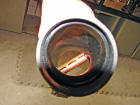 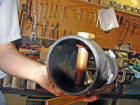 Pictures at left are the venturi tube in the intake elbow before the
turbo, the turbo draws the CNG into the engine.
Around $1800 for a CNG
diesel/conversion system, another $3800 for a new 30 gallon
carbon fiber tank and it isn't cheap. My tanks were used,
similar to what you find on EBay. But if you put miles on
your truck like I do (30k/year), it can still pay for itself
in a year depending on which state you get most of the CNG
from. Those of use towing trailers across the country can
benefit the most, because we spend the most on fuel. Pictures at left are the venturi tube in the intake elbow before the
turbo, the turbo draws the CNG into the engine.
Around $1800 for a CNG
diesel/conversion system, another $3800 for a new 30 gallon
carbon fiber tank and it isn't cheap. My tanks were used,
similar to what you find on EBay. But if you put miles on
your truck like I do (30k/year), it can still pay for itself
in a year depending on which state you get most of the CNG
from. Those of use towing trailers across the country can
benefit the most, because we spend the most on fuel.
We
haven't dyno'd the test truck yet. I'm hearing from folks
using CNG and propane boost that they get from 60 to 100 hp
increase. It's easy to see the power boost, flipping the
switch with the cruise control on. Nice on the Interstate
on-ramp with a trailer, the extra power helps. I'm sure the
130 octane from CNG, and cooler condensed air caused by the
pressure drop from 3600 psi in the tank to 200 psi in the
regulator, all contribute. We ran hoses from the trucks
recirculation reservoir to the regulators to keep them from
freezing from the pressure drop.
Having the correct spring setting in the regulator, controls
how much CNG goes in the engine and at what RPM the engine
sucks in the natural gas mixture.
The unit has adjustments for
pressure and volume. You use less throttle for the same RPM,
because of the reduced diesel consumption. Fine tuning the
volume control determines how much flutter you have when you
let off the throttle or drop below the RPM that gas is drawn
in. That was around 1600 rpm on my test truck. Torque peak
on a 6.0L Power Stroke is 1800 rpm, so I gained some bottom
end power.
  In
Detroit I drove Louie Fecteau's
2001 GMC Sierra 2500HD
Duramax/Alison with the Deluca CNG dual fuel conversion. He
had similar fuel economy improvements and said turbo lag was
eliminated. Louie installed a new Lincoln Composites CNG 21
GGE Tank, carbon fiber composite 30 gallon
tank, 200 lbs verses my two tanks weighing 400 lb. In
Detroit I drove Louie Fecteau's
2001 GMC Sierra 2500HD
Duramax/Alison with the Deluca CNG dual fuel conversion. He
had similar fuel economy improvements and said turbo lag was
eliminated. Louie installed a new Lincoln Composites CNG 21
GGE Tank, carbon fiber composite 30 gallon
tank, 200 lbs verses my two tanks weighing 400 lb.
Louie's truck stutters
at 1500 rpm when CNG shuts off. Louie changed to a lighter
spring in the regulator for his first generation Duramax
with less vacuum for better CNG fumigation draw. Louie put
his regulators in front of rear wheel well on the drivers side.
Marc Deluca installed his regulators in the engine
compartment of his GM Duramax. My unit is installed in the
bed next to the tanks along with pressure gauge and fill
nipple.
Found my
trucks sweet spot for fuel savings and drivability. Changed
volume setting 5 times, highest setting had 3 CNG to 1
diesel. But it was surging at highway speeds as anytime the cruise control adjusted itself on hill or wind, the reaction was a surge or pulse at set speed. Adjusted volume
down,
took the surge out, drivability is now same with or without
gas. So I can have it on all the time.
The amount of natural gas that
will fill your tank depends if the fuel dispenser is 3600
psi or 3000 psi and if it's a hot day or a cold night.
30 gallon tank equals 21 gallons CNG in general, my two 10
gallon tanks equal 13 gallons at 3000 psi 17 gallon at 3600
psi. I should be able to load 18 gallons on a hot day
into my 20 gallon tank.
Towing a trailer had a
23% reduction
($.10) in cost per
mile, from $.43 to .33. MPG improved 12% from 9.08 to 10.3
miles per gallon combined both fuels. 22.2 mpg CNG, 19.18
mpg diesel. This fueling at less than one to one, .75 CNG to
1 part diesel.
Empty truck had a
27% reduction in cost per mile, from
$.26 to .19. MPG improved 8% from 15.36 to 16.48 combined
fuels. 26.92 mpg CNG, 42.53 mpg diesel at 2 CNG to 1 part
diesel.
This is with diesel at $3.94 and CNG at $2.74 in Colorado, September 08.
CNG is sold as Gasoline Gallon Equivalent equal to gas in
BTU units at 114,100 blended by Xcel Energy to achieve said
BTU.
Using my gallons
used for CNG and diesel, I converted to Utah prices for CNG
and diesel. Average diesel price in Utah was $3.59 the same
week I paid $3.94 in Colorado, CNG in Utah averaged $.88
with Colorado as one of the highest states for CNG prices at
$2.74
Towing a trailer on Utah fuel could have a 45% reduction in
cost per mile from $.40 to $.22. Empty truck could have a
48% reduction in cost per mile from $.23 to $.12. Can you
imagine driving for $.12 a mile? It would be equivalent to
driving a car that got 30 mpg on $3.50 gas. Tempted to move
to Utah or Oklahoma. From what I've found, CNG is from $.50 to $1.20 a gallon
cheaper than diesel.
Turbo boost dropped in half using CNG.
I think with a boost regulator, increasing boost would allow
using more CNG or an injection system.
Other diesel engines may have the ability to use CNG more
efficiently, that will be another review, maybe a Cummins or
Cat. This is the largest increase of fuel savings we
experienced on our test truck 2006 Ford F250 Power Stroke
diesel.
One of the benefits of natural gas as fuel, is they burn
cleaner, releasing smaller amounts of by-products of
combustion (carbon particulates and acids) into the motor
oil.
Because the oil stays cleaner longer, it’s possible to
expect longer intervals between oil changes.
At the CNG pump in Colorado is a $.06 a gallon Federal
Excise Tax. This may be deductable with the IRS. There are
incentives, grants and rebates associated with alternative
fuels like CNG. In an effort to reduce
America's dependence on foreign oil,
reduce emissions and greenhouse gases, the US federal and
state governments have incentives to encourage the purchase
and use of natural gas vehicles (NGVs). Conversions
especially for diesels may or may not meet EPA requirements,
most are sold for off-road use, be sure to do your on
research.
Tax
Incentives
|
Use to see refineries burning
off natural gas to get it out of the way. Now
natural gas will play a major role in American
trucking.
In California, Clean Truck Programs at
the Port of Los Angeles and Long Beach, which starts (Oct. 08), bans trucks 1988 and older
from entering the ports. January 1st 2010, trucks
model year 1989-1993 will be banned from port
terminals along with unretrofitted 1994-2003 trucks.
On January 1, 2012, all trucks must meet 2007
federal clean truck emission standards. Using
natural gas in port trucks can reduce green house
emissions by 20 percent and nitrogen oxide emissions
by 75 percent. Sterling is producing for the port a
truck powered by a Cummins Westport spark-ignited
natural gas engines. Well maybe not, Daimler just
announced the demise of Sterling in March of 2009.
So more than likely Sterling's big brother,
Freightliner will have natural gas trucks for the
ports. The extra cost of the NG engines is being
covered by grants from California.
Total Transportation Services, Inc., a
transportation company in Rancho Dominguez, CA,
trucks to the Ports of Los Angeles and Long Beach.
TTSI is operating eight Kenworth T800 liquefied
natural gas (LNG) trucks, the first alternative-fuel
vehicles to operate in full-time drayage service at
the Ports of Los Angeles and Long Beach under the
major Clean Trucks Program.
Liquefied Natural Gas,
LNG is better quality, takes less
space for fuel tanks compared to CNG. But takes
special insulated tanks for 260 degrees below zero
to keep it liquid.
TTS's eight Kenworth T800s are
equipped with the LNG fuel system developed by
Westport Innovations Inc. of Vancouver, B.C., and
installed on the Cummins ISX 15L engine. The
Kenworth T800 LNG Cummins ISX 15L engine has 450-hp
and delivers 1,650 lb.-ft. of torque. The Kenworth
trucks have Westport’s High Pressure Direct
Injection (HPDI) technology and use five percent
diesel and 95 percent natural gas.
Earlier this decade, Cummins
Westport Inc., a joint
venture of
Cummins
Inc. and
Westport
Innovations Inc., in 2001 completed the
first multiple-unit delivery of heavy-duty trucks
using the low-emissions ISX-G heavy-duty natural gas
engine. The multiple-unit delivery involved 14
Peterbilt heavy-duty trucks to Sanitary Fill Company
in San
Francisco, a subsidiary of
Norcal Waste Systems Inc.
Read the Norcal Waste Systems
natural gas truck test at
http://afdc.energy.gov/afdc/pdfs/35427.pdf The
liquefied natural gas was hauled from Wyoming to
Sacramento CA in 2001, because of the high cost of
transporting LNG to California, diesel fuel was
cheaper than LNG. The test did show the
diesel/natural gas engines performed better than the
spark-ignition engines in prior test.
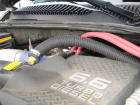 Back to pickup
truck natural gas conversions, there are four types
of tanks, all-metal or aluminum, hoop-wrapped steel
or aluminum, fully-wrapped steel or aluminum, all
composite, carbon fiber. Cylinders are stamped with
expiration date when then need recertified from 15
to 20 years. Most fumigation
diesel/cng conversions are for off
road use only, as far as emissions certifications on
the mechanical system goes. Deluca states that his
new electronic system will be emission compliant.
http://www.delucafuelproducts.com/ I interviewed a school bus
company owner that tried CNG a decade ago. In a test trip
cross country found different CNG fill nipples in
each state. They had to wait while the next nipple
came to them UPS. Now there are just two nipples at
fill stations across the country, fleet size and
public size. Back to pickup
truck natural gas conversions, there are four types
of tanks, all-metal or aluminum, hoop-wrapped steel
or aluminum, fully-wrapped steel or aluminum, all
composite, carbon fiber. Cylinders are stamped with
expiration date when then need recertified from 15
to 20 years. Most fumigation
diesel/cng conversions are for off
road use only, as far as emissions certifications on
the mechanical system goes. Deluca states that his
new electronic system will be emission compliant.
http://www.delucafuelproducts.com/ I interviewed a school bus
company owner that tried CNG a decade ago. In a test trip
cross country found different CNG fill nipples in
each state. They had to wait while the next nipple
came to them UPS. Now there are just two nipples at
fill stations across the country, fleet size and
public size.
Normal driving, diesel/cng
conversion kits lower boost and EGT's (exhaust gas
temperature), but just like a programmer, drive
hard, tow big trailers in the mountains and you can
increase EGT heat. More power produces heat. As with
engine power modifications, you should add an EGT
gauge to your truck with a diesel/cng conversion.
When we first installed the diesel/cng conversion
kit on our 2006 Ford F250, the clutch did slip a
couple of times. Figuring it was caused by the extra
power, it hasn't happened since. Even though we are
pleased with our CNG volume setting, occasionally
driving in town at lower rpm's will produce some
surging.
Installation in a Ford
F250 Power Stroke Diesel below. I inspected the same
system in GM Duramax diesel and Dodge Cummins
diesel.
Here
is a chart on alternative fuel fill stations across
the country.
|
STATE |
BD |
CNG |
E85 |
ELEC |
HY |
LNG |
LPG |
Totals
by State |
|
Alabama |
16 |
3 |
6 |
0 |
0 |
0 |
46 |
71 |
|
Alaska |
0 |
1 |
0 |
0 |
0 |
0 |
10 |
11 |
|
Arizona |
10 |
40 |
19 |
5 |
1 |
5 |
50 |
130 |
|
Arkansas |
2 |
3 |
6 |
0 |
0 |
0 |
37 |
48 |
|
California |
37 |
183 |
10 |
370 |
25 |
28 |
199 |
852 |
|
Colorado |
22 |
20 |
56 |
2 |
0 |
0 |
55 |
155 |
|
Connecticut |
1 |
9 |
2 |
3 |
1 |
0 |
16 |
32 |
|
Delaware |
3 |
1 |
1 |
0 |
0 |
0 |
3 |
8 |
|
Dist. of Columbia |
1 |
1 |
3 |
0 |
1 |
0 |
0 |
6 |
|
Florida |
12 |
15 |
15 |
3 |
2 |
0 |
47 |
94 |
|
Georgia |
28 |
18 |
28 |
0 |
0 |
0 |
37 |
111 |
|
Hawaii |
7 |
0 |
0 |
4 |
1 |
0 |
3 |
15 |
|
Idaho |
6 |
7 |
4 |
0 |
0 |
1 |
25 |
43 |
|
Illinois |
4 |
17 |
186 |
1 |
1 |
0 |
54 |
263 |
|
Indiana |
6 |
13 |
110 |
0 |
0 |
0 |
28 |
157 |
|
Iowa |
5 |
0 |
95 |
0 |
0 |
0 |
24 |
124 |
|
Kansas |
5 |
2 |
24 |
0 |
0 |
0 |
44 |
75 |
|
Kentucky |
1 |
0 |
11 |
0 |
0 |
0 |
13 |
25 |
|
Louisiana |
1 |
5 |
3 |
0 |
0 |
0 |
10 |
19 |
|
Maine |
5 |
1 |
0 |
0 |
0 |
0 |
8 |
14 |
|
Maryland |
6 |
14 |
12 |
0 |
0 |
0 |
13 |
45 |
|
Massachusetts |
7 |
11 |
1 |
18 |
0 |
0 |
23 |
60 |
|
Michigan |
17 |
14 |
58 |
0 |
7 |
0 |
69 |
165 |
|
Minnesota |
1 |
1 |
353 |
0 |
0 |
0 |
30 |
385 |
|
Mississippi |
5 |
0 |
2 |
0 |
0 |
0 |
34 |
41 |
|
Missouri |
8 |
7 |
77 |
0 |
1 |
0 |
75 |
168 |
|
Montana |
4 |
3 |
2 |
0 |
0 |
0 |
31 |
40 |
|
Nebraska |
3 |
2 |
36 |
0 |
0 |
0 |
18 |
59 |
|
Nevada |
14 |
11 |
17 |
0 |
2 |
0 |
28 |
72 |
|
New Hampshire |
11 |
3 |
1 |
8 |
0 |
0 |
11 |
34 |
|
New Jersey |
0 |
11 |
0 |
0 |
0 |
0 |
10 |
21 |
|
New Mexico |
7 |
10 |
7 |
0 |
0 |
0 |
49 |
73 |
|
New York |
5 |
92 |
15 |
1 |
1 |
0 |
29 |
143 |
|
North Carolina |
66 |
12 |
13 |
0 |
0 |
0 |
44 |
135 |
|
North Dakota |
0 |
4 |
26 |
0 |
0 |
0 |
14 |
44 |
|
Ohio |
22 |
8 |
61 |
0 |
0 |
0 |
66 |
157 |
|
Oklahoma |
6 |
51 |
5 |
0 |
0 |
0 |
64 |
126 |
|
Oregon |
36 |
12 |
8 |
9 |
0 |
0 |
29 |
94 |
|
Pennsylvania |
6 |
26 |
19 |
0 |
1 |
0 |
63 |
115 |
|
Rhode Island |
0 |
7 |
0 |
2 |
0 |
0 |
4 |
13 |
|
South Carolina |
73 |
4 |
71 |
0 |
0 |
0 |
20 |
168 |
|
South Dakota |
0 |
0 |
79 |
0 |
0 |
0 |
17 |
96 |
|
Tennessee |
48 |
4 |
22 |
0 |
0 |
0 |
52 |
126 |
|
Texas |
54 |
17 |
35 |
1 |
0 |
4 |
497 |
608 |
|
Utah |
7 |
62 |
5 |
0 |
0 |
0 |
22 |
96 |
|
Vermont |
2 |
1 |
0 |
2 |
1 |
0 |
5 |
11 |
|
Virginia |
12 |
9 |
6 |
1 |
1 |
0 |
19 |
48 |
|
Washington |
35 |
14 |
12 |
0 |
0 |
0 |
52 |
113 |
|
West Virginia |
1 |
2 |
3 |
0 |
0 |
0 |
7 |
13 |
|
Wisconsin |
3 |
19 |
113 |
0 |
0 |
0 |
45 |
180 |
|
Wyoming |
14 |
8 |
6 |
0 |
0 |
0 |
26 |
54 |
|
Totals by Fuel: |
645 |
778 |
1644 |
430 |
46 |
38 |
2175 |
5756 |
I'm planning my next horse expo tour trip to
Missouri today, just went on
www.cngprices.com and used their "Trip Planner"
and found the CNG fill stations on the way. The new
way to travel, plan your fuel route along with your
highway route. I hope this isn't the end of the
story as we need a national energy plan and CNG has
promise. I still remember when the Alaskan Pipeline
was going to save us a few decades ago. Look up
sometime where the Alaskan pipeline oil goes.
|
|
Important websites for more on CNG
http://www.myphill.com/
http://www.pickensplan.com/
http://www.cngprices.com/ http://www.ngvglobal.com/
http://www.ngvamerica.org/ US Energy Stations Map
Tax
Incentives
CNG Forums
|
|
With
diesel and gas prices doubling in one year, no one was prepared
for this. We knew higher prices were coming and oil is running
out, but not all at once. We all feel the pain, from fuel
prices. But the good side and there always is a good side if you
look hard, the dramatic fuel price increase has put the whole
country on alert speeding up development and brain storming for
a solution.
Mark Deluca explained that CNG makes the engine more efficient,
diesel explodes in the center bowl of the piston and leaves some
oxygen and diesel unburned in the outside ring of the piston.
CNG helps use the fuel and oxygen in the outside ring, giving
you more power. Diesel engines compress hot air and CNG for a
more complete burn of fuel and air in the compression stroke.
Since adding the CNG venturi tube in the air snorkel after the air
filter, the low pressure fumigation system, CNG fuel is sucked into the
turbo and mixes air with CNG as it travels through the turbo and
intercooler on it's way to the engine. No CNG is used at idle
and it takes about 1500 rpm to open the spring valve on the
regulator for the gas to flow. Drawing CNG into intake manifold
has advantages over bio-diesel or waste oil which goes thru
pumps and injectors causing some problems on seals and o-rings or
gelling from cooking oil waste/fuel.












